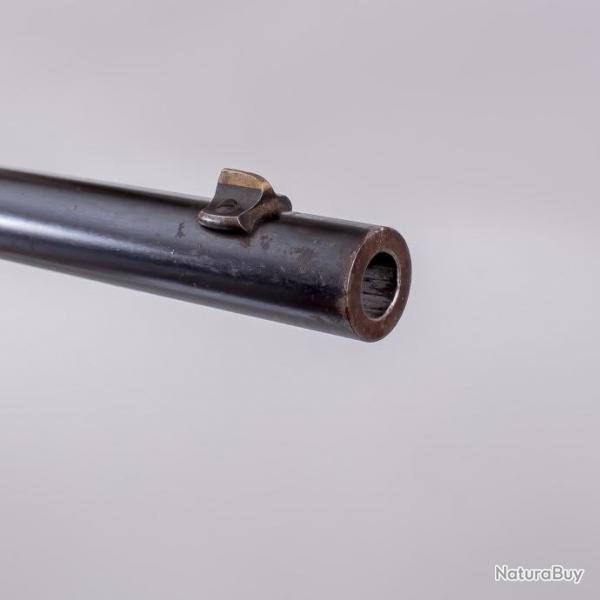Can y’all take a look at this rifle and comment on the fit finish and quality? I’m looking for an 1894 carbine in 30/30.
WINCHESTER 94 30-30 CARBINE for sale (gunsinternational.com)
[email protected] said
Can y’all take a look at this rifle and comment on the fit finish and quality? I’m looking for an 1894 carbine in 30/30.WINCHESTER 94 30-30 CARBINE for sale (gunsinternational.com)
I see nothing wrong with it, though it is priced just a tad too high in my opinion.
Bert
WACA Historian & Board of Director Member #6571L

Edward Kitner said
I saw a model 1885 in very nice condition but with out a serial number. What does this suggest?
That the lower tang has been replaced. Unserialized replacement lower tang & trigger assemblies could be ordered from the factory. I’d expect a significant discount for a gun in this cond.
Hello and greetings from Belgium.
Wanna see some examples?
A while ago, I noticed a Winchester 1895 Russian contract for sale in an auction. The pictures in the advertisement were most probably taken by a professional. Whow, that realy looked like just the one that I was searching for.
But a closer look made me think twice. Here are some examples that also are discused in the tips Bert gave (I blew up the pictures because otherwise you wouldn’t be able to see the details)
The wood looked ecxellent, see? And that makes the whole gun look better than it actually is.

But then…
1. To my humble opinion it was freshly recrowned. No smudge whatsoever in the scraping and stopped recrowning before all the blue marking was gone (didn’t even take the trouble of making a tool for sanding it nicely):
2.Whilst recrowning, it had to be held in a vise, of course (who the hell is so clumsy to let it slip out and damage the gun?):
3. There is pitting in the receiver that looks a bit too clean for an old gun. Looks like the receiver took a chemical bath with who knows what product that could turn out badly in the long run and, looking at the schrathes, it also underwent a ‘steelwool therapy’ with not the finest steel wool:
4. And say, what a nice bore:
5. Does this point to a bayonet or a poor recrowning tool? I’m not sure but even if it is caused by a bayonet, it turns me off a bit.
Rcvr has been cleaned, maybe wood too, but not with heavy-hands. Doubt muzzle has been re-crowned. Marks on wood & brl don’t look like vise marks to me, just careless handling, very possibly by the auction staff, as I’ve seen them do before. For a military rifle that’s gone through war, revolution, & careless arms dealers, it really doesn’t look that bad to me.
November 7, 2015
 Offline
OfflineIf you think the bore has been relined, Werner, take a good look at the breech end. It’s not unreasonable to conclude this rifle has been through at least two wars and no small amount of careless or rough handling. Sometimes a fully trained and equipped armorer simply isn’t available when repairs need to be made. Cleaning the metal and adding a bit of oil to the wood is probably required maintenance for an old warhorse like this one. Like you, I’m a bit concerned with the bore but I’ll bet it shoots nice! May want to take a closer look.
Mike
TXGunNut said
If you think the bore has been relined, Werner, take a good look at the breech end. It’s not unreasonable to conclude this rifle has been through at least two wars and no small amount of careless or rough handling. Sometimes a fully trained and equipped armorer simply isn’t available when repairs need to be made. Cleaning the metal and adding a bit of oil to the wood is probably required maintenance for an old warhorse like this one. Like you, I’m a bit concerned with the bore but I’ll bet it shoots nice! May want to take a closer look.
It’s common for military rifles to be shot little, but roughed up much, & otherwise abused & neglected; though the worst treatment often occurs after they’ve left service & been sold to an arms dealer..
tony g said
Don’t forget, verify the gun is right as Bert explained above, I cannot stress that enough. THEN always buy the highest condition you can afford. Second rate rifles will always be second. High condition will always be in high demand. If you are bored with it a few years later, or you want to move from a 73 to an 86, you will sell high condition the easiest, fastest, and for the best money.The only real exception to buying condition, is when a gun is so rare, you may not get a chance at another one for 10 years or something like that. Example would be serial number 17 winchester 73 that sold for over 100K. It was just a medium patina gun that would have been worth $2500 in a high serial number, but WOW it is number 17. Chances for guns like that are very rare.
Look at 73 trappers, scarce guns and most of them are brown blah condition, right? But everyone wants one and they bring big premiums.
Look at 85 low-wall carbines. Probably only 50 of them still floating around in the world, and it is believed only 2-3 of them have any condition. The rest (including mine) are all brown blah guns. But look at the high prices.
Nothing good will come cheap. If you are always looking for the deal, you will never have a great collection, just an average one. Rare is rare and if you want to build an exceptional collection, sooner or later you will have to “pony up” for either condition, or rarity. God help you if the bug bites you to buy a super rare rifle in minty condition!!! Collecting antique guns is a disease!!!
Look at 85 low-wall carbines. Probably only 50 of them still floating around in the world, and it is believed only 2-3 of them have any condition. The rest (including mine) are all brown blah guns. But look at the high prices.
And most of them are in Australia. Ive owned 3
All looks legit to me. It’s just missed a lot of abuse that most of them have seen. MIGHT HAVE SAT IN THE CORNER OF SOME UPPER ECHELON officer’s office in WWI for some time and missed most of the battles and may have not been issued for WWII. The bore condition is suspect. I know some guys are really good at relining bores so that it’s nearly invisible, thus the work on the crown. The lack of blue is probably bayonet wear. Sorry about the caps….
I’d love to own it!
CowboyBelge said
Bert,What do you think? An example of a no-go or a gun that is in better condition than the usual?
(after all, it ‘s your topic)
By the way: If the gun was kept in a corner of a high ranked officer and didn’t see the battle field, how do we get to bayonet wear then?
That’s merely one possibility; many military detachments just don’t see front line service. I’ve seen countless US military rifles in 100% MINT cond. How did that happen?
If you’ve seen other Russian ’95s in Europe, you’d be a better judge of “usual” cond than most in this country.
By the way, is barrel lining widely available where you live? This does not seem to me to be the type of gun on which many owners would spend the cost of a lining job.
CowboyBelge said
Bert,What do you think? An example of a no-go or a gun that is in better condition than the usual?
(after all, it ‘s your topic)
By the way: If the gun was kept in a corner of a high ranked officer and didn’t see the battle field, how do we get to bayonet wear then?
I am of the opinion that the wood has been lightly sanded and refinished, but that the steel surfaces are original, including the bore. That stated, the pictures are not detailed enough to make any definitive statements about the gun.
Bert
WACA Historian & Board of Director Member #6571L

Bert H. said
I am of the opinion that the wood has been lightly sanded and refinished, but that the steel surfaces are original, including the bore. That stated, the pictures are not detailed enough to make any definitive statements about the gun.
There’s pitting on the right side of rcvr that looks like it’s been wire-brushed; don’t know how else to make it that “clean.”
clarence said
There’s pitting on the right side of rcvr that looks like it’s been wire-brushed; don’t know how else to make it that “clean.”
@ Clarence: A chemical bath would clean that pitting without wire-brushing.
@ Bert: I have no idea of how common relining is in Europe. That is to say: I know that there are gunsmiths who do that but I don’t know how often.
I was thinking:
A parade gun would have nice wood and the bayonet would have been on and of nearly daily for drill practices and the gun would never have been shot. Also regiment guards would take the bayonet on and off every day and probably never shot their guns, especially if they are guards in training camps, at gouvernement buildings or just camps behind the front line in general. The same goes for guns that were used by photographers (the Russian soldiers loved to send a picture home, just like all soldiers in those days). I include one of those. These guns, just like parade guns, were never fired and the bayonet probably went off and on very often. A bore guide would also cause that wear in the (very) long run but I don’t think that that would be used by the Russians. Or, as I said before: a poor crowning tool with outside guide. But maybe the parade or guard or photographer gun is more likely. Still don’t like the look of that wear but I guess it’s one thing or the other: a new looking bore and bayonet wear or a not so nice bore and a good looking blueing on the barrel end.
Pretty sure that it has been re-crowned. That round shape, rough edge, the left-over from the blue color marking and no smudge whatsoever on it, immediately made me think. So, because some here are of the opinion that it’s original, I looked up some pictures of how it actually should look like. Here’s a picture of the muzzle of a non-Russian contract 1895. You can see that it is flat, not round.
The other picture is of the muzzle on a Russian contract but isn’t as clear as the other one. Nevertheless: flat crown.
So, I might be wrong but still my opinion stays that it has been re-crowned.
1 Guest(s)


 Log In
Log In Members
Members Home
Home

 Add Reply
Add Reply Add Topic
Add Topic















